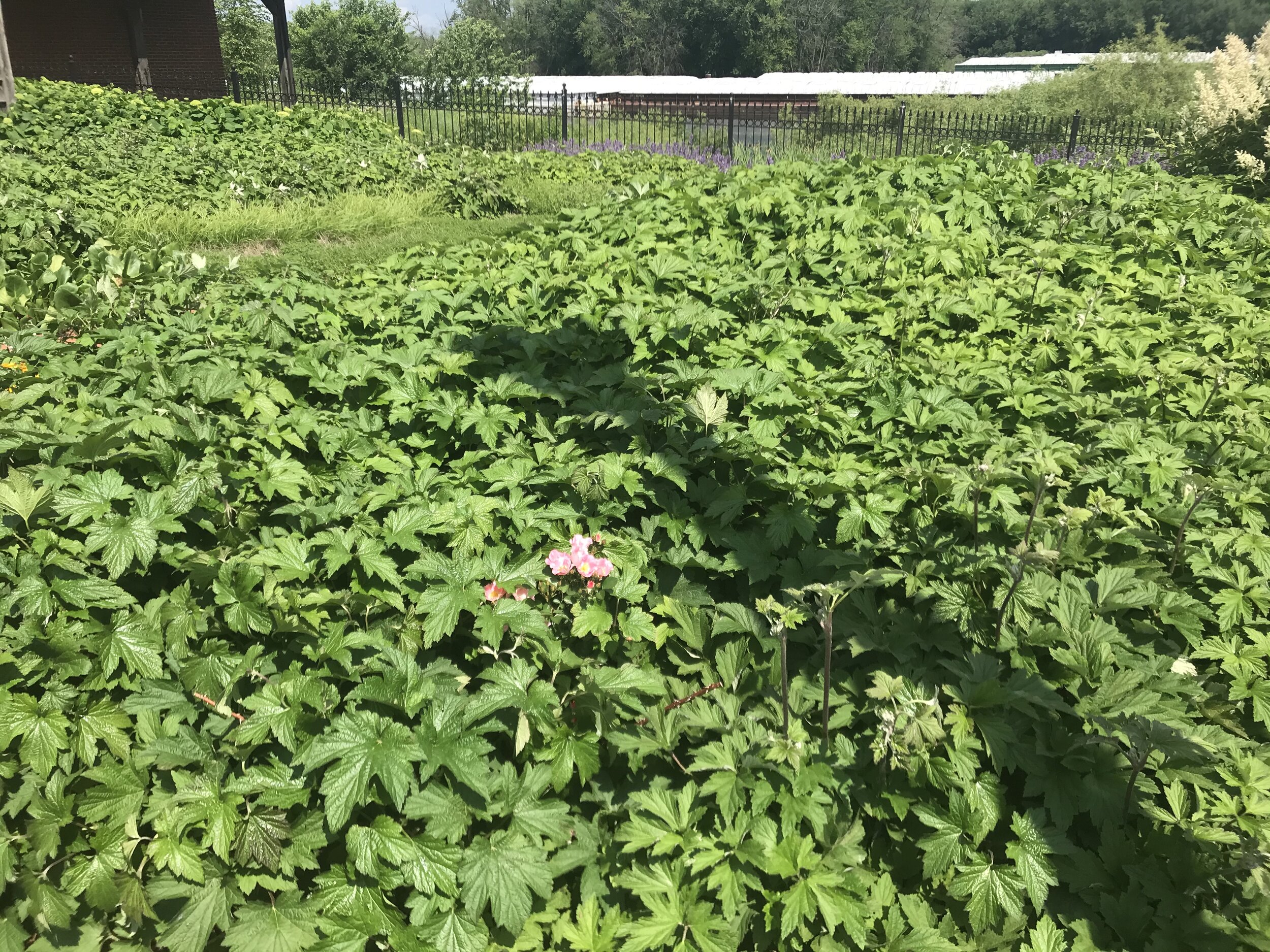A Walk in the Garden
One staff member’s thoughts about the “seventh” gallery at the Minnesota Marine Art Museum
Welcome to paradise!
I have been learning from the gardens at the Minnesota Marine Art Museum for 13 years. Although, I shouldn’t count the first several years because I wasn’t paying much attention. My own gardening interests are pretty new. When my husband and I bought our house in 2012, I started poking around the parking lot plant displays at big box stores and would grab whatever was in bloom at that moment. Inevitably, I made all the rookie mistakes of having no foundation plants and nothing for winter interest. I plopped full-sun plants in part-shade places, and there were a few bad decisions I am still working to get rid of ... I’m talking about you Bishop’s Weed!
As my own interest in my home garden has grown, I have watched the gardens at the Museum intently to learn all that I can. I have noticed which plants have dominated, which have died out over the years, which shrubs look best at their full size, and which plants shine the brightest at different times of the year. Read on to learn my non-professional, novice gardener, highly personal thoughts and observations.
A fabric of colors and textures interweave to create a seventh gallery at the Minnesota Marine Art Museum.
The gardens at MMAM can be categorized as American Prairie Style. They were designed and are still maintained by Mark A. Swart and his crew at Sundance Grasses and Perennials, a landscape company based in Winona. MMAM’s gardens measure 3.5 acres contain more than 60,000 plants, shrubs, grasses and trees. Many of these plants are considered native to our region.
Sometimes we refer to the gardens as our “seventh gallery,” because the outdoor space surrounding the building was very intentionally designed.
According to Swart:
The purpose of all of this is to create an atmosphere that introduces the incredible art on display at the Museum. From the moment you drive through the gates you will be stepping into a time and space created to relax and open your mind to fully appreciate what the artists depicted in their paintings, photographs, and sculpture.
This still image reminds me that I need to take a short video of the breeze blowing through the Prairie Dropseed grass in late summer at its full height because movement is the element of this plant that makes it so magical.
That’s a really unique garden goal. It can also work as intended if folks take a minute to slow down and notice the gardens before they come inside the Museum. We talk about “elements of art” like color, line, shape, light, texture and space inside the Museum all of the time. Plants exhibit these same elements. The balance, contrast, proportion, and patterns created in the garden can, in fact, prepare you to be a more astute “looker” once inside.
To me, the most intentional and successful design element in the MMAM gardens is a 600 square foot mass planting of Prairie Dropseed (Sporobolus heterolepis) grass. This large expanse of grass is planted directly parallel to the Mississippi River and borders the riverwalk, a place to sit and enjoy the view of the river. The Prairie Dropseed allows visitors the opportunity to do just that. It doesn’t compete for attention, but instead echoes and highlights aspects of the river. As the wind blows the fragrant tall grass, these incredible waves occur and it has the same flow as the river. It is truly a perfect plant for that space, and I give so much credit to Swart for knowing that it would have this effect.
See the pink flower? That’s a lone remaining Shrub Rose called “Carefree Delight” getting swallowed alive by the Japanese Anemone. Hang in there rose!
I’ve learned that terms like “vigorous” and “reliable” are often code words to describe plants that can be a beast in the garden. Japanese Anemone (Anemone x hybrida “September Charm”), sometimes called “windflower,” is one of these plants. These plants spread underneath the soil via rhizomes, or horizontal roots, that pop down more roots at the nodes and spring up new growth above the soil. I picture fingers growing from fingers growing from fingers (repeat). However, if you have to pick a garden bully, this would be the one to get. Pictured here, it’s preparing to send up buds for hundreds of delicate pink blooms that last forever. It is the plant that we get the most questions about at the front desk because it is truly stunning.
1,
2.
3.
The first picture showcases the same space in 2008 planted with yellow coreopsis, pink shrub rose, and two small Japanese Anemone. Look how the Anemone has taken over in the second picture, taken just this week (June 2020). The third picture shows the blooms that the Japanese Anemone “September Charm” will eventually produce in about two more months.
If this picture of Nepeta had sound effects, you would hear swarms of bees buzzing around this miraculous plant.
I can’t believe I don’t yet have Nepeta in my own garden. It gets more beautiful every year. The silvery blue foliage contrasts so nicely against its green neighbors and the purple bloom stalks rebloom if cut back. One of the first docents I had the pleasure of working with here at the Museum taught me all types of cool things about plants. One of those cool things is that all mint plants have square stems and opposite leaves. Thank you Harry Buck! I think of you everytime I pick a stem of this beautiful plant and feel the square stem. Nepeta racemosa ‘Walker’s Low’ (Catmint) is planted in big drifts throughout the gardens, and in every location it looks fantastic. The block of color and texture that it gives is both a focal point for your eye, and a feast for the bees.
Like most gardeners, my favorite plant is whatever is in bloom. In June, I’m always crazy for Goatsbeard (Aruncus dioicus). I’m not sure what specific variety this clump is, but I love the height and drama that it gives this garden bed, and the way the soft creamy plumes blur away at their edges making a cloud like silhouette.
This stand of Goatsbeard is a stunner in June towering over the Nepeta and surrounded by Japanese Anemone.
I’d love to know what’s looking great in your garden right now. Like many of us, gardening has been a huge source of self-care for me these past few months in quarantine. Please send me an email (hcasper@mmam.org) with your pictures and recommendations.
I invite you to explore the Museum’s seventh gallery! The gates are open Tuesday-Sunday from 10 a.m. until 5 p.m., and there are a few peaceful paths that you can wander through. There is no need to pay admission unless you plan on coming inside (and you should do that too, but if you need a quick 15 minute garden fix, drive on over!) The birds and bees that love this garden are an entirely extra layer of fun to observe in addition to the plants.
Hope to see you wandering the gardens soon,
Heather Casper
Curator of Education and Wannabe Master Gardener









